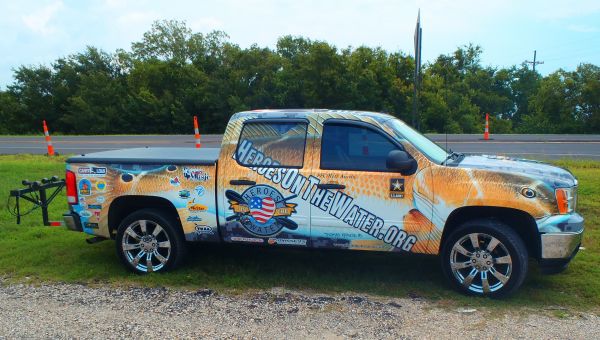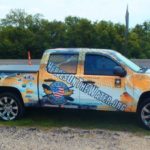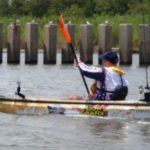
’Yaking relieves injured warriors’ stresses
All kayak fishermen know that ’yak fishing is a special sport, and there’s just something soothing from being so close to nature and being in the boat by yourself. That feeling is now being used to help our wounded military heroes get some of that same relief and “therapy.”
The newly revamped Heroes on the Water (HOW) program aims to put these veterans in kayaks for a day of much more than “just” fishing.
There are other worthy programs that take injured veterans fishing, but HOW is different. Instead of being catered to on a guided trip, these guys and gals get to do it on their own.
HOW serves all military personnel who have been wounded, injured or disabled. What looks like a day trip of paddling and fishing for wounded vets is, in fact, something much deeper and long-lasting. The official HOW motto is: “Healing wounded spirits — Restoring warrior’s hearts through kayak fishing.”
The Louisiana chapter coordinator is Gairi Williamson of Kenner. Williamson is a long-time kayak fisherman who saw a chance to give something back to these vets who have given so much for us and our country.
“You’re close to the water, and you’re going to catch fish eventually,” Williamson said. “It’s therapeutic; it’s quiet. It’s you and there’s nobody else out there. It’s a healing event for those who need it.”
Local kayak fishermen stepped up in support of HOW, and donated several kayaks and fishing gear to get the program rolling. The aim is to have everything necessary to provide these wounded heroes with a turn-key day of fishing and fun.
As the chapter grows, plans are to hold more special events and tournaments that will spotlight the veterans.
There is no better ambassador for HOW than Jason Austin. He terms himself as a “volunteer and participating veteran.” However, Austin knows all-to-well what wounded military heroes go through and what the program means to them; He is one.
Five years ago, Austin sustained severe injuries from an IED explosion while serving in Iraq. He is a retired sergeant first class military policeman, and has been a member of HOW since 2010 when he joined the Tampa chapter.
He first heard about HOW in 2007 when he was in the hospital following his injuries in Iraq.
Austin was in several hospitals, medical hold units, community-based healthcare organizations and warrior transition battalions for over 900 days. He had cervical and lumbar injuries, left frontal and parietal brain injury, hearing and vision loss, and his right leg and abdomen required surgery.
After three years of surgeries, rehabilitation, in-patient programs and cognitive therapy, Austin was medically retired from the military in 2010.
“About 900 days later, the army decided they were done putting me back together, and I went home,” Austin said.
Returning and adjusting to civilian life was not easy. “You go from sitting in a dark room and not wanting to be social to this. My life ended here in the military, and started here with kayak fishing,” he said.
An avid kayak fisherman, Austin is a perfect ambassador for HOW. He knows first hand how these vets feel, and knows what kayak fishing can do for them.
“A lot of us that come back with injuries think our life as we knew is over,” he said. “What are you going to do? This actually challenges you to get out there and paddle. You feel a sense of accomplishment that normally you lose in that transition period coming home.”
Austin actually credits kayak fishing with saving his life.
“I know kayak fishing saved my life,” he said. “I had a world convinced I was OK, but my demons won more battles than I did. Kayak fishing gave me something to look forward to — therapy for myself and group therapy when I fished with friends.”
Not all military injuries are physical. Post traumatic stress disorder (PTSD) is a disability that many military veterans cope with. Although they may look physically fine, vets suffering from PTSD find it difficult to cope with normal life activities.
The HOW program provides participants a chance to decompress from the stresses associated with combat, as well as the physical rigors of rehabilitation.
In an effort to bring more attention to HOW, Austin recently got his truck and kayak wrapped by Lion Grafix with an impressive redfish print that also features the HOW logo and several program sponsor logos. He even added a QR code so smart phone users can click on the truck and go directly to the HOW Web site to get more information.
Not stopping there, Austin planned a ’yaking expedition all around Lake Pontchartrain to continue raising awareness of HOW. He plans on paddling 175 to 200 miles around the lake to share the HOW mission. He also expects to get people on the water with him as they paddle through different areas around the lake.
Kayaking is very popular across South Louisiana, and Williamson has plans to bring the HOW experience to as many veterans as possible. While the primary goal of HOW is to serve injured veterans, Williamson generously offers the group’s services to any veterans.
“We want to spread the kayaking experience to as many veterans as possible,” he said. “If you know a vet that wants to try kayak fishing, have them get in touch with our chapter.”
The program provides basic kayak-fishing instruction, angling clinics and paddling classes for participants with skill ranging from beginners to the most-experienced paddlers. The program assists these injured veterans in adapting these newly developed skills to their new abilities.
Kayaks, PFDs, paddles, fishing gear, meals and transportation are provided free of charge to every participant. The volunteer-only staff and program coordinators donate their time and expertise in support of the military heroes that HOW serves.
*Heroes on the Water has over 35 chapters in 22 states across the country, and is constantly looking to expand the program. They accept volunteers, and donations of cash, kayaks and fishing related gear.




